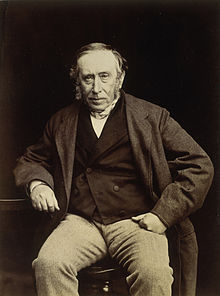James Syme
| James Syme | |
|---|---|

James Syme, c. 1855
|
|
| Born | 7 November 1799 Edinburgh |
| Died | 26 June 1870 (aged 70) Millbank House near Edinburgh |
Prof James Syme FRCS FRSE DDL (7 November 1799 – 26 June 1870) was a pioneering Scottish surgeon.
James Syme was born on 7 November in Edinburgh. His father was a writer to the signet and a landowner in Fife and Kinross, who lost most of his fortune in attempting to develop the mineral resources of his property. James was sent to the Royal High School at the age of nine, and remained until he was fifteen, when he entered the University of Edinburgh. For two years he frequented the arts classes (including botany), and in 1817 began the medical curriculum, devoting himself with particular keenness to chemistry. His chemical experiments led him to the discovery that a valuable substance is obtainable from coal tar which has the property of dissolving india-rubber, and could be used for waterproofing silk and other textile fabrics; an idea which was patented a few months afterwards by Charles Macintosh, of Glasgow (see also Mackintosh).
Syme married the sister of his former colleague, Robert Willis.
In the session 1818–1819 Syme became assistant and demonstrator of the dissecting room of Robert Liston, who had started as an extramural teacher of anatomy in competition with Liston's old master, Dr John Barclay; in those years he held also resident appointments in the infirmary and the fever hospital, and spent some time in Paris practising dissection and operative surgery. In 1823 Liston handed over to him the whole charge of his anatomy classes, retaining his interest in the school as a pecuniary venture; the arrangement did not work smoothly, and a feud with Liston arose, which did not terminate until twenty years later, when Syme settled in London.
...
Wikipedia
